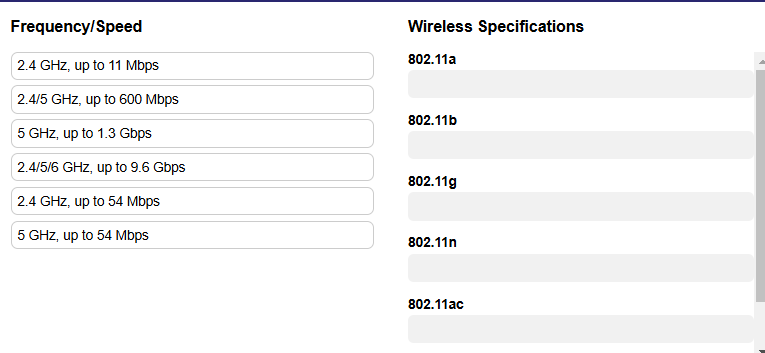What are the frequency and speed specifications for different wireless standards?

Understand the Problem
The question is asking about the frequency and speed specification of wireless standards, likely seeking comparisons or definitions of each standard listed. This involves understanding how different wireless specifications translate to performance.
Answer
802.11b: 2.4 GHz, 11 Mbps; 802.11a: 5 GHz, 54 Mbps; 802.11g: 2.4 GHz, 54 Mbps; 802.11n: 2.4/5 GHz, 600 Mbps; 802.11ac: 5 GHz, 1.3 Gbps; 802.11ax: 2.4/5/6 GHz, 9.6 Gbps.
The specifications match as follows: 802.11b: 2.4 GHz, up to 11 Mbps; 802.11a: 5 GHz, up to 54 Mbps; 802.11g: 2.4 GHz, up to 54 Mbps; 802.11n: 2.4/5 GHz, up to 600 Mbps; 802.11ac: 5 GHz, up to 1.3 Gbps; 802.11ax: 2.4/5/6 GHz, up to 9.6 Gbps.
Answer for screen readers
The specifications match as follows: 802.11b: 2.4 GHz, up to 11 Mbps; 802.11a: 5 GHz, up to 54 Mbps; 802.11g: 2.4 GHz, up to 54 Mbps; 802.11n: 2.4/5 GHz, up to 600 Mbps; 802.11ac: 5 GHz, up to 1.3 Gbps; 802.11ax: 2.4/5/6 GHz, up to 9.6 Gbps.
More Information
Wireless standards vary in their frequency bands and maximum speeds. The newer standards generally offer higher speeds and more frequency options.
Tips
A common mistake is confusing frequency bands and speeds for different standards. Make sure to check both frequency and speed specifications for accuracy.
Sources
- 802.11 Wireless Standards Explanation and Comparison - FS.com - fs.com
- IEEE 802.11 - Wikipedia - en.wikipedia.org
- Wi-Fi Standards Explained - GeeksforGeeks - geeksforgeeks.org
AI-generated content may contain errors. Please verify critical information